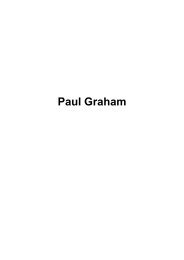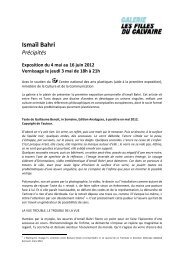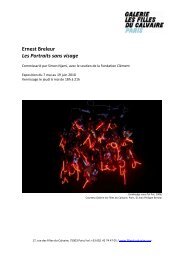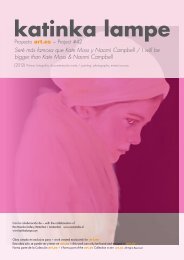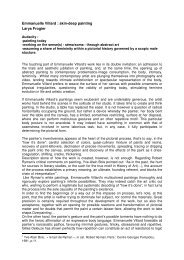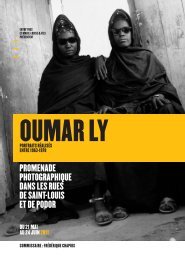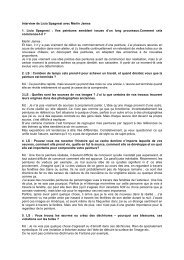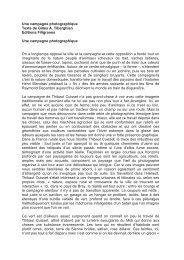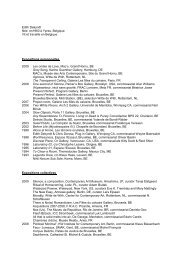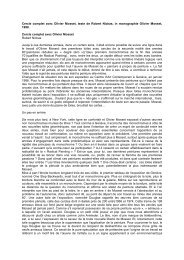antoine d'agata - Galerie Les Filles du Calvaire
antoine d'agata - Galerie Les Filles du Calvaire
antoine d'agata - Galerie Les Filles du Calvaire
You also want an ePaper? Increase the reach of your titles
YUMPU automatically turns print PDFs into web optimized ePapers that Google loves.
8 RUE FRANCOIS-VILLON<br />
75015 PARIS - 01 53 68 65 65<br />
fact what matters hère is not so much the<br />
resulting image as the act that went into<br />
making it, lis performative power and im<br />
plicit physical involvement, ils revelation of<br />
the artists presence in the world ln exhibitions,<br />
d'Agata assembles his images in<br />
big, cumulative montages, confrontmg the<br />
viewerwith the impossible truth of ecstatic<br />
bodies overflowmg with an energy that so<br />
metimes pushes beyond the frame Forget<br />
romantic self-in<strong>du</strong>lgence in despair, this<br />
work is about a "frantic effort to belong to<br />
life, to be in life, and alive '<br />
ln your practice the photographer is not a<br />
w/tness but someone who enfers into an inn<br />
mate relation with the world in the process<br />
exposing lus own body especially sexually<br />
Horn do you view the distance between the<br />
camera and the photographed world<br />
When I started takmg photographs, I used al<br />
cohol to brmg down the barrier between the<br />
camera and the world Sex look over from<br />
that and the photographie act become the<br />
wild exploration of extreme drives, an<br />
openmg to the brutal mystery of the other<br />
For many years I used to take photos with<br />
my arm stretched out, not looking in the<br />
viewfmder Then I started dispossessmg my<br />
self of the camera and of the movement of<br />
takmg the shot, by getting the girls I was<br />
spendmg my nights with to take part, fundamentally<br />
challengmg the distribution of<br />
rôles in the pro<strong>du</strong>ction of images Renoun<br />
cing the photographie act means I can became<br />
a character and object in a script I<br />
Gould seemyself existing in the f rame, strug<br />
gle with my own existence This was deci<br />
sive I get nd of the heavy baggage of the<br />
photographer as witness and regamed real<br />
f reedom of action To date, some f ifty people<br />
have operated the camera in my place<br />
You define photography as a practice intr/n<br />
sically linked to a position a lived experience<br />
and also as a martial art<br />
For me it's an art of social warfare and ils<br />
philosophical foundations are chaos ineo<br />
herence and violence, but it's also a disci<br />
plme that requires mtransigence and<br />
patience, all the way to the less of dignity<br />
and of the need for rules The faceless bodies<br />
of these I photograph are no longer<br />
their bodies their bellies are swollen by<br />
drugs and drink, their foreheads are low<br />
and their shoulders sunk Re<strong>du</strong>ced to the<br />
state of commodities by the logic of<br />
money they pillage kill, rape and struggle<br />
to exist outside any kmd of social or cultu<br />
rai logic The violence of their actions goes<br />
unrepressed because they themselves are<br />
its mam targets This is the unspeakable<br />
and unrepresentable contemporary horror<br />
the most cruel social and economie aliéna<br />
lion imaginable This experience of vio-<br />
BAL<br />
5889505300502/CLA/OTO/2<br />
lence is central to my perception of art<br />
And, while trymg to take it to rts ultimate<br />
hmits, I daim to make it into material that is<br />
legible for a spectator to whom it is alien<br />
That is the paradoxof my work, which goes<br />
from pure mtensity to a no doubt<br />
intolérable formai utterance<br />
FORM AND THE UNFINISHED<br />
/ get the impression that the aesthetic of<br />
your images bas changea They saem more<br />
frontal with less blurr/ng and camera move<br />
ments just as the colors are more purple<br />
less reddish Mas your photographie method<br />
changea?<br />
I have always used techniques that I don t<br />
master, so as not to be in control After<br />
workmg with gelatm silver for about ten<br />
years, two years ago I started workmg with<br />
a digital camera, mitially for financial reasons<br />
But this technology also allows me to<br />
explore the space that links photography<br />
to video images and to permanent flux ln<br />
that sensé what I photograph is no longera<br />
moment but a situation that I break down<br />
For many years my work was re<strong>du</strong>ced to a<br />
kmd of expressions effect but that wasn t<br />
what it was about at all The out of focus<br />
quality was a toei an attempt to reveal<br />
other levels of reality, by relymg only on<br />
chance and the chaotic conditions of the<br />
photograph, but I don't want it to become a<br />
styhstic tic<br />
ln 2006 you made the film Aka Ana and your<br />
la tes t film Atlas features prominently in this<br />
show at Le Bal What does this form give you?<br />
I now use the contmuous time of video,<br />
which leaves less room for lies than the<br />
photographie illusion The impenous need<br />
to live what I daim to be documenting leads<br />
to an inévitable slide from what one could<br />
consider the (photographie) idea towards<br />
(cinematographie) action I am fightmg for<br />
an art of gesture, of the moment an art that<br />
is obscène and amoral. To construct this<br />
film I assembled a score of monologues by<br />
women l'd met in some ten différent coun<br />
tries At Le Bal I present these voices in<br />
space They are totally absent from the pho<br />
tographs When I am editmg, I work on the<br />
images and voices separately creating two<br />
parallel successions of fragments which<br />
each follow their own logic, so that the two<br />
interprétations become superimposed and<br />
mutually contradictory<br />
You often refer to this inévitable contradiction<br />
in your work with an action that is itself un<br />
compromising but also a désire for the work to<br />
exist and be seen How do you conceive this<br />
transition towards the visibilityofthe work?<br />
I need to feel sure that at some point the<br />
work will achieve a more or less complète<br />
form, so that there's no misunderstandmg<br />
FEVRIER 13<br />
Mensuel<br />
Surface approx. (cm²) : 3658<br />
with the viewer Atthesametime I don't ne<br />
cessanly want to explam I constantly run<br />
the risk of leavmg everythmg unfinished<br />
That's why I feel forced—wrongly, per<br />
haps—to go back over thmgs to publish<br />
and to show ln that case the exhibition becomes<br />
an opportunity to put a provisional<br />
form on a provisional state of aff a i rs ln rea<br />
Illy, I still see it all asa series of abortive at<br />
tempts, but I keep trymg, in spite of the<br />
lassitude and the feelmg of compromise<br />
And there are other factors I live and work<br />
in a very fragile economy, with no safety<br />
margins, and if Tm going to contin ue then I<br />
need the work to be seen even if, agam,<br />
this is in contradiction with my instinctive<br />
désire for invisibihty<br />
There is a fundamental distinction in your<br />
work between night and day the personal<br />
and the pol/tical That leads to two types of<br />
images which eventually marge into one a<br />
process that is embodied in the show by a<br />
gigantic installation of your /mages<br />
For a long time this distinction between<br />
day and night was an unconscious one Be<br />
cause I am represented by a photography<br />
agency (Magnum) I sometimes fmd myself<br />
in the position of bemg able to report on the<br />
state of the world by gomg to photograph<br />
some of ils symptoms, such as urban reno<br />
vallon, areas of economie migration or<br />
armed conflict I have never had any<br />
qualms about allowmg myself to be the<br />
frustrated hostage of a commission,<br />
because the strategie and pohtical issues<br />
facmg the press are very real But the way I<br />
photograph in these situations is cold and<br />
distanced, the emotional economy totally<br />
opposed to my commitment in the places<br />
and moments of my extreme expériences<br />
The gaze behind these images of eur limes<br />
is sériai and systematic lt makes invente<br />
nes of other processes, like these anthro<br />
pometnc portraits made by the American<br />
police that I gleaned from the Internet ln<br />
the end, if I juxtapose images on a wall it's<br />
because I want to préserve the chaos and<br />
integnty of each lived moment, as an autonomous<br />
fragment The need to accumulate<br />
is the same as in 2003, when with Christian<br />
Caujolle I showed a thousand images in an<br />
exhibition in Paris Because I wanttocreate<br />
meanmg I can't be happy with just showmg<br />
a sampling of "pretty images " Bemg<br />
agamst narrative, I have to keep rejecting<br />
narrative pretexts or pre formatted styles<br />
I d like to lalk about the pohtical dimension of<br />
your work your way of looking at the world of<br />
prostitution which at the same time becomes<br />
a pnsm for a ferocious critique of capitalism<br />
People are always challengmg me with the<br />
moral question of prostitution, with my re<br />
lation tothegirls But I have the same moral<br />
Eléments de recherche : LE BAL : centre de création documentaire contemporaine, au 6 impasse de la Défense à Paris (18e), toutes citations<br />
Page 6/7



